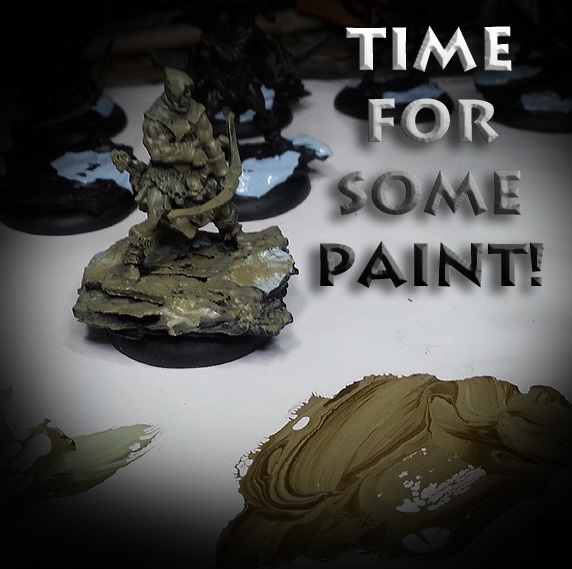All right folks, time for some of those step by step images I told you about. This is going to be a modified version of my Shaded Basecoat technique.
The point to this technique is to allow me to paint large numbers of figures in a much easier fashion, using a simplified mix of colors. The simplification means that matching something which may have been painted long ago will be a lot easier! I won't even need the same jars of paint, since I am not relying on any one specific color.
Normally I prime things grey, but this was a unique situation where the figures would have to be attached to the bases prior to painting. I definitely prefer to paint this pinned to a dowel rod off the base, but the unique set of circumstances dictated otherwise.
I knew from the many previously painted figures that a lot of tans, browns and gray would be involved. So, I was going to take the same few colors that would be used to paint the rocks of the base right up through the figure itself.
Using the filbert brush, I mixed together a greenish tan, starting at about midtone level, halfway between dark and light. All of this is done very rapidly. Keeping inside the lines, so to speak, is not part of the shaded basecoat technique. This is very similar to blocking in colors as if you were doing a 2D painting.
The plan is to quickly designate areas that I want to be more light, and to drop down the colors needed on the base, fur, and other spots that will be a grayish brown in the end. Also, I want to have an 'underpainting', which subsequent layers of skin colors and such will be added later.
I moved along each of the ten figures, gradually lightening the mix that I was applying. It is important to note that I am not dry brushing. The paint is damp enough to flow cleanly. The shape of the filbert brush allows me to place these oblique angle strokes in such a way that I can catch details without losing my darker areas.
I will eventually progress all the way to the lightest lights.
Another side benefit of this method is that I am firmly reminded to keep the lightest highlights on the upper surfaces! Working "globally" across the entire figure all at once in this manner prevents me from getting locked into one area, and ending up with a foot that has the same intensity of highlights as the top of the head or shoulders!
Lighter and lighter I go...
In all this time, I have used the same blue/white color and the same dark sepia.
All of the undercoating is complete, and I have a much better idea of where I want light and dark to be placed.
To this, I will start to add some 'unique' colors, such as the skin, cloak, and hood colors. This first skin color layer is applied in a slightly transparent manner, so that the underpainting comes through.
Doing so will allow some of the cooler greens to come through this new layer, and add more depth to the skin color with a lot less effort!
I will do a similar 'shaded basecoat' layering on this skin color... working from that middle tone all the way up to the highlight.
Keep in mind, the shadow areas will be created with those later glazes!
Yes, all of these ghostly pale skin tones that you see now will have a host of shading and tinting added to them. Again, this allows me to not only get through all ten of these in a more speedy fashion, but this color scheme can be replicated over and over again without the need to remember any formulas, or rely on specific colors.
We all have had favorite paint colors be discontinued. Therefore, I try to keep any color scheme down to 5-7 core colors, usually ones that could be made by my if the need arose.
Stay tuned for the next episode, where I tackle some of the other shades of tans and greenish black!
The Shaded Basecoat technique is featured in all of my instructional videos, but it is also shown to a higher detail in the first of all the titles... Shaded Basecoat Technique.
That is available at Kings Hobbies and Games:














